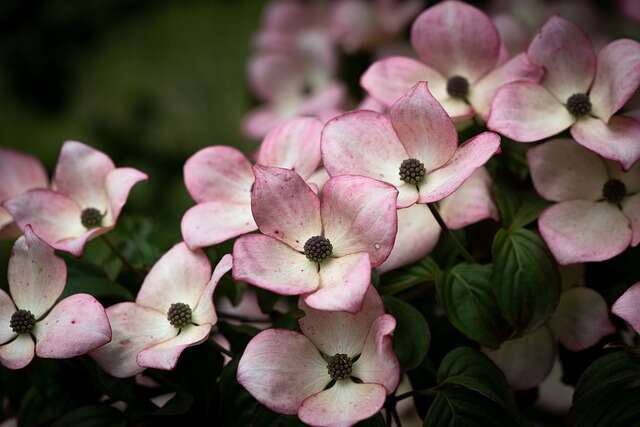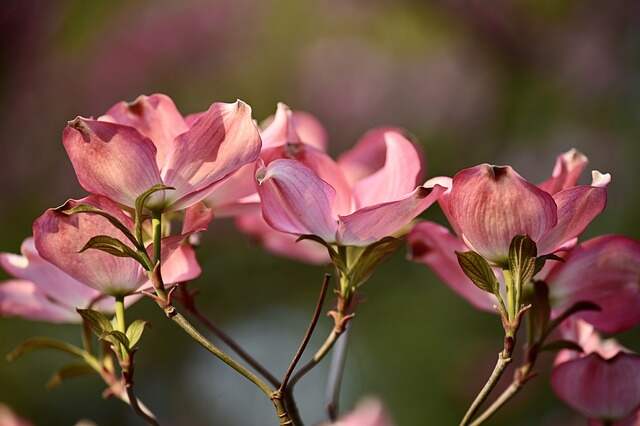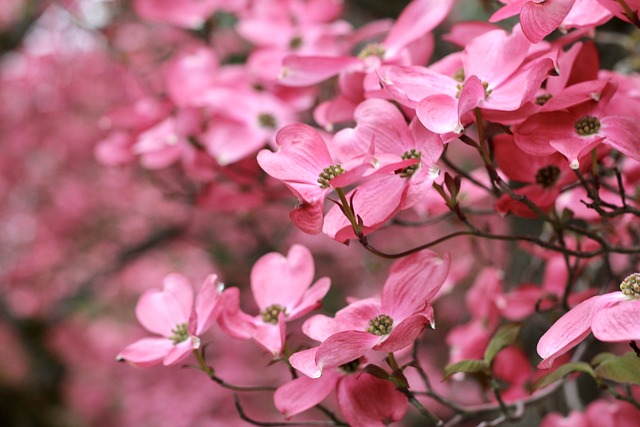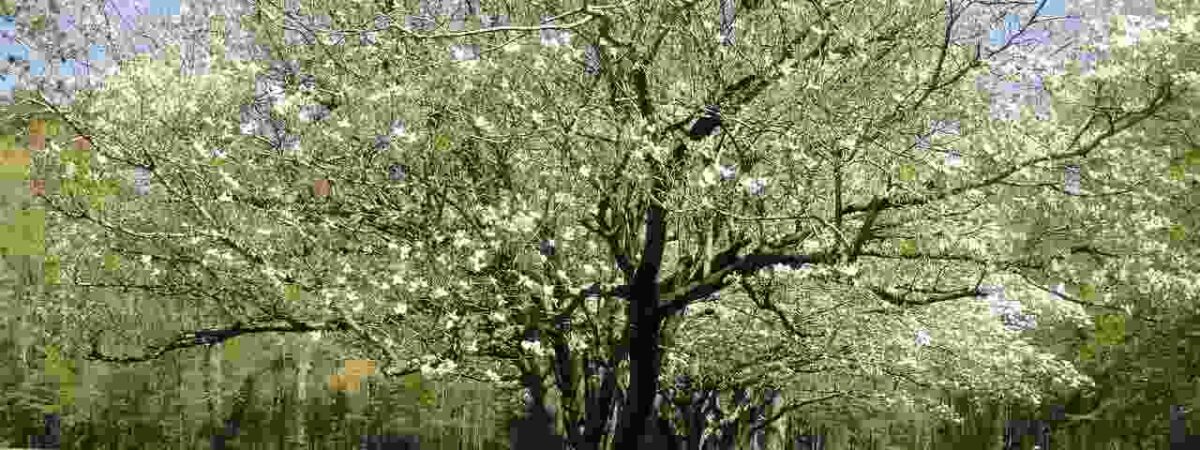Flowering dogwood trees are a beautiful addition to any landscape, with their delicate pink or white blooms and bright red berries. These trees are native to North America and are widely cultivated for ornamental purposes.
Whether you’re planting a new dogwood tree or caring for an existing one, proper care is essential for its growth and health. In this article, we will provide you with the information you need to grow and care for flowering dogwood trees.
Plant Overview
The flowering dogwood (Cornus florida) is a small, deciduous tree that is prized for its showy spring flowers, which are often pink or white, and its attractive fall foliage, which turns shades of red, purple, and yellow.
The tree grows up to 30 feet tall and has a rounded canopy that spreads 25-30 feet wide. It has a rounded form and a spreading canopy, making it ideal for use as a specimen tree or in groups.
The tree’s leaves are oval and medium green, turning a vibrant red or purplish red in the fall. The tree’s showiest feature is its profusion of delicate pink or white blooms that appear in the spring. The blooms are followed by bright red berries that are popular with wildlife, including birds.
Importance of Flowering Dogwood Trees in Landscaping

Flowering dogwood trees are an important addition to many landscapes due to their attractive appearance and relatively small size. The striking flowers in the spring, attractive foliage in the fall, and beautiful bark make this tree a popular choice for adding year-round interest.
Additionally, flowering dogwoods are often used as accent plants or to form focal points in garden designs. They are also used in mixed borders and naturalistic woodland gardens. Due to their modest size, flowering dogwoods are also suitable for use in small gardens or as understory trees in larger landscapes.
Overall, the flowering dogwood tree provides a beautiful and versatile option for adding interest to any landscape.
Types of Flowering Dogwood Trees
There are several different types of flowering dogwood trees, including:
Cornus florida:
The most common type of flowering dogwood, native to North America. This species is known for its large, showy spring flowers and attractive fall foliage.
Cornus kousa:
Native to Asia, this species is also known as the Kousa dogwood. It has similar flowers and foliage to C. florida but blooms later in the spring.
Cornus nuttallii:
This type of dogwood is also known as Pacific dogwood. It is native to the Pacific Northwest region of North America and has larger flowers and leaves compared to C. florida.
Cornus controversa:
This type of dogwood is also known as giant dogwood. It is a larger species, growing up to 60 feet tall, and has a distinctive, multi-stemmed growth habit.
Cornus mas:
This species is native to Europe and Asia and is also known as the Cornelian cherry. It is prized for its early spring flowers and edible fruit.
These are some of the most common types of flowering dogwood trees, each with its own unique characteristics and attributes. It is important to choose the right species for your specific landscape needs.
When and Where to plant a dogwood tree?

The best time to plant a flowering dogwood tree is in the spring or fall. The tree should be planted in a hole that is large enough to accommodate its root system, but not so large that it allows the roots to dry out. The soil should be gently firmed around the roots to eliminate any air pockets, and the tree should be watered thoroughly. It is important to mulch around the base of the tree to retain moisture and control weeds.
The flowering dogwood is a hardy tree that can grow in a range of soils, but it prefers well-drained soils that are moist but not waterlogged. The tree can grow in partial shade, but it will produce the most blooms in full sun. Choose a site for your flowering dogwood that has good air circulation to prevent disease problems. When planting a new tree, make sure to space it appropriately to allow for adequate room for growth.
How to plant a dogwood tree?
Here is a general guide on how to plant a dogwood tree
Choose a suitable location:
Dogwood trees prefer partial to full sun and well-drained soil. Make sure the area you choose is large enough for the tree to reach its mature size.
Prepare the soil:
Before planting, amend the soil with compost or well-rotted manure to improve its fertility and drainage. If the soil is heavy clay, consider raised beds or mounds to improve drainage.
Dig a hole:
Dig a hole that is two to three times wider than the root ball of the tree and has the same depth. This will help the roots establish themselves quickly and easily.
Plant the tree:
Carefully remove the tree from its container or wrapping and place it in the hole. Make sure the root collar is level with the soil surface. Backfill the hole with soil, gently tamping it down as you go to eliminate air pockets.
Water the tree:
Water your plant properly to help settle the soil and remove any air pockets. Make sure the soil stays moist but not waterlogged, especially during the first few weeks after planting.
Mulch:
Spread a 2-3 inch layer of mulch around the base of the tree, being careful not to pile it up against the trunk. Mulch helps the soil of plant to conserve moisture, regulate soil temperature, and suppress weeds.
Stake the tree (if necessary):
If the tree is tall or top-heavy, you may need to stake it to provide support until it becomes established.
By following these steps, you can help ensure that your dogwood tree will thrive in its new home.
Caring guide of a dogwood tree

Light
The flowering dogwood tree (Cornus florida) prefers partial to full sun. It will grow in full shade, but it may not produce as many flowers or have as bright fall foliage. Ideally, a flowering dogwood tree should receive at least 4-6 hours of direct sunlight each day to perform at its best.
If planted in full sun, it is important to provide adequate moisture to prevent leaf scorch or wilting. In hotter climates, planting tree in dappled shade or providing afternoon shade can also help reduce stress.
Water
The flowering dogwood tree (Cornus florida) prefers moist, well-drained soil. It is drought tolerant once established, but regular watering during dry periods is beneficial for maintaining healthy growth and promoting flower production.
In general, a newly planted dogwood tree should be watered once a week, providing about 1 inch of water per week. Established trees can usually get by with less frequent watering, but it is still a good idea to water them deeply during periods of drought to keep the soil consistently moist.
It is important to avoid over-watering, which can lead to root rot. It is also a good idea to mulch around the base of the tree to help conserve moisture and regulate soil temperature.
Soil
The flowering dogwood tree (Cornus florida) prefers well-drained soil with a slightly acidic pH (between 5.0 and 6.5). It is adaptable to a wide range of soils, but it grows best in rich, organic soil.
The tree does not tolerate poorly drained or waterlogged soils, as these can lead to root rot. If you have heavy clay soil, consider planting your dogwood tree in a raised bed or on a mound to improve drainage.
Adding compost or well-rotted manure to the soil prior to planting can also help improve fertility and drainage. In general, a flowering dogwood tree will perform best in soil that is consistently moist but not waterlogged, and that is well-drained and rich in organic matter.
Temperature
The flowering dogwood tree (Cornus florida) is native to the eastern United States and is well adapted to the temperate climate of this region. It is hardy in USDA zones 5-9, which means it can withstand winter temperatures as low as -20°F (-29°C).
The tree is not particularly tolerant of extreme heat and is best suited to areas with cool summers and moderate winter temperatures.
In general, flowering dogwood trees grow best in climates with moderate temperatures and moderate to high humidity. If you live in a hot, dry climate, it is important to provide adequate moisture and shade to prevent stress and leaf scorch.
Humidity
The flowering dogwood tree (Cornus florida) prefers moderate to high humidity. It is native to the eastern United States, where it grows in a humid, temperate climate.
The tree is relatively tolerant of drought, but it grows best in conditions of moderate to high humidity, especially during the growing season. In hot, dry climates, it is important to provide adequate moisture to prevent leaf scorch and to maintain healthy growth.
In general, a flowering dogwood tree will perform best in a climate with moderate temperatures, moderate to high humidity, and adequate rainfall. If you live in an area with low humidity, you may need to water your tree more frequently to keep the soil consistently moist, and you may also want to consider using a humidifier to improve the indoor growing environment.
fertilizer
The flowering dogwood tree (Cornus florida) is relatively low maintenance and does not require a lot of fertilizer to thrive. However, a light application of balanced fertilizer can help promote healthy growth and flower production.
Fertilize newly planted trees in the spring, just before new growth begins. For established trees, fertilize once in early spring and again in mid-summer. A balanced, slow-release fertilizer with a ratio of 10-10-10 or a fertilizer specifically formulated for trees and shrubs can be used.
How to prune a dogwood tree?
Pruning is an important part of maintaining a healthy and attractive flowering dogwood tree (Cornus florida). Here are some general guidelines for pruning a dogwood tree:
Prune your dogwood tree in late winter or early spring, before new growth begins. This allows you to see the structure of the tree clearly and make clean cuts.
You can prune your dogwood tree by the following
Remove dead, diseased, or damaged wood:
Cut back any dead, diseased, or damaged wood to healthy wood. This helps reduce the risk of pests and diseases and also improves the overall appearance of the tree.
Thin out crossing or rubbing branches:
Remove any branches that cross or rub against each other, as these can cause wounds and increase the risk of disease.
Maintain an open center:
To encourage good air circulation and sunlight penetration, remove any branches growing in the center of the tree.
Avoid topping the tree:
Topping is a practice of removing the entire top of the tree, leaving stubs. This can be damaging and lead to weak growth. Instead, remove individual branches to maintain the natural shape of the tree.
Make clean cuts:
Always make clean, straight cuts just above a bud or branch collar. Avoid leaving your stubs, or else it can lead to disease and insect problems.
Seek professional help:
If you have any concerns or are unsure about how to prune your dogwood tree, it is always a good idea to consult with a professional arborist for guidance.
By following these pruning guidelines, you can help maintain the health and beauty of your flowering dogwood tree for many years to come.
Pest and Disease Management

The flowering dogwood tree (Cornus florida) can be susceptible to a number of pests and diseases, but with proper care and management, these problems can be prevented or controlled. Here are some of the most common pests and diseases to watch for and how to manage them:
Dogwood anthracnose:
This is a fungal disease that causes leaf spots and cankers on the twigs and branches. To prevent infection, avoid overhead watering, provide adequate air circulation, and remove and destroy infected leaves and twigs.
Dogwood borer:
This insect pest attacks the trunk and branches of dogwood trees, causing them to become weak and die. Keep the tree healthy by providing proper moisture and nutrition, and remove any infested branches.
Scale insects:
These pests feed on the sap of dogwood trees, causing yellowing leaves and stunted growth. Control scale by pruning and destroying infested branches, and applying horticultural oil in the winter.
Japanese beetles:
These beetles feed on the leaves of dogwood trees, leaving behind skeletonized leaves. Control Japanese beetles by handpicking and disposing of them, or by applying an insecticide.
Powdery mildew:
This fungal disease causes a white, powdery coating on the leaves, twigs, and flowers of dogwood trees. To prevent infection, provide adequate air circulation and sunlight, and avoid overcrowding.
By monitoring your dogwood tree for signs of pests and diseases, and taking appropriate action as needed, you can help keep your tree healthy and attractive for many years to come. If you have any concerns about pests or diseases affecting your dogwood tree, it is always a good idea to consult with a professional arborist for specific recommendations for your climate and soil type.
Conclusion
Growing and caring for a flowering dogwood tree (Cornus florida) requires attention to several key factors, including proper planting, light and water requirements, soil conditions, temperature and humidity, and pruning and pest/disease management.
By providing the right growing conditions and following good cultural practices, you can help your dogwood tree thrive and enjoy its beautiful spring flowers for many years to come.
It is important to remember that each tree and growing environment is unique and that the specific needs of your dogwood tree may vary based on your climate and soil type.
If you have any questions or concerns about growing and caring for your dogwood tree, it is always a good idea to consult with a professional arborist or horticulturist for tailored recommendations.
Alocasia Plant Love: How to Nurture and Grow These Stunning Plants
How to create a garden that thrives in a specific climate or weather condition?






